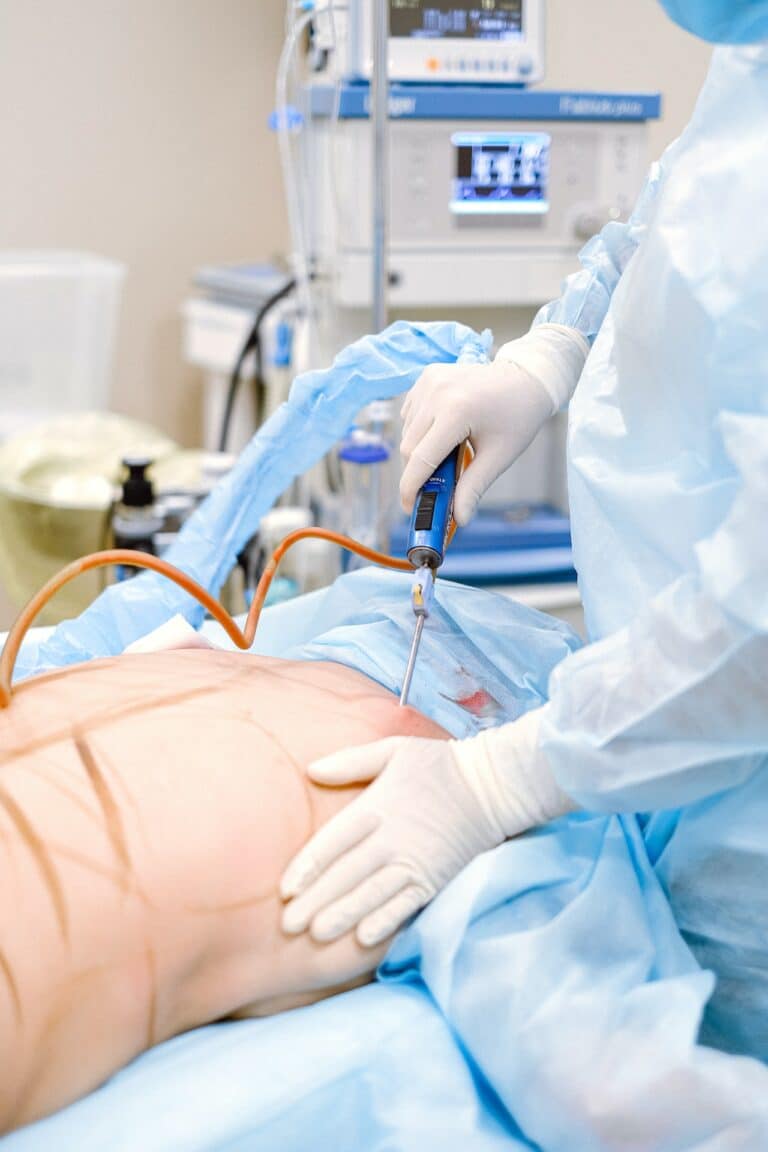Surgical Symphony: How Belt Lipectomy Harmonizes Body Proportions
A belt lipectomy, often referred to as a lower body lift, stands out as an advanced cosmetic surgery designed to reshape and tone the midsection, buttocks, and thighs. This procedure addresses excess skin and fat resulting from significant weight loss or natural aging processes. By removing surplus skin and tightening the remaining tissue, patients achieve a more contoured and aesthetically pleasing silhouette. Ideal candidates are those who have stabilized their weight loss efforts and seek to eliminate sagging skin that cannot be addressed through exercise alone.
Understanding the Concept of Lipectomy
Surgical Removal
Lipectomy is a surgical procedure. It aims to remove unwanted fat from the body. This process can target various areas where excess fat accumulates.
Surgeons use special tools during this operation. They carefully extract fat tissues without harming surrounding areas. The goal is to achieve a more contoured body shape.
Types of Lipectomy
There are several types of lipectomies, each with its purpose.
- Traditional lipectomy focuses on removing large amounts of fat.
- Belt lipectomy, specifically, targets the midsection and lower back area.
- Other types might concentrate on arms, legs, or the face.
Each type serves different needs based on patient goals. For example, someone wanting to improve their waistline might choose a belt lipectomy.
Primary Goals
The primary goals of these procedures are twofold:
- To enhance physical appearance by reducing excess fat.
- To improve health outcomes related to obesity-related conditions.
Patients often experience increased self-esteem post-surgery. They also notice improvements in mobility and overall quality of life.
However, it’s crucial for patients to have realistic expectations about results. Success depends on individual factors like skin elasticity and general health.
Overview of Lower Body Lift (Belt Lipectomy)
Targeted Areas
A belt lipectomy focuses on improving the shape and tone of underlying tissue. It targets several areas.
The procedure mainly addresses the abdomen, buttocks, and thighs. Specifically, it lifts the buttocks and tightens the lateral thighs. This comprehensive approach ensures a smoother, more natural body contour.
Patients notice significant changes after recovery. The abdomen becomes flatter and firmer. The buttocks get an uplifted appearance. And the lateral thighs see a reduction in sagging skin.
Benefits
The benefits of a belt lipectomy go beyond aesthetics.
Firstly, patients enjoy improved body contours. They feel more confident in their appearance. Secondly, there are functional benefits too. Reduced excess skin can decrease irritation and infections in skin folds.
Here’s a quick list of benefits:
- Enhanced body shape
- Increased confidence
- Reduction in skin-related issues
Typical Candidates
Not everyone is a candidate for this surgery.
Ideal candidates are individuals with significant soft tissue looseness in one or multiple body areas. They should be non-smokers who have stable weight for at least 12 months. Candidates must also have realistic expectations about what surgery can achieve.
Preparing for Belt Lipectomy Surgery
Medical Evaluations
Before undergoing belt lipectomy, patients must complete several pre-operative tests. These evaluations ensure the patient is a good candidate for surgery. They typically include blood tests and imaging scans to assess overall health.
Patients may also undergo cardiac screening. This is especially important for weight loss patients with a history of heart issues. The surgeon will review these results carefully before proceeding.
Lifestyle Adjustments
Making lifestyle changes is crucial prior to surgery. Patients should stop smoking at least four weeks before the procedure. Smoking can delay healing and increase the risk of complications.
A balanced diet rich in vitamins and proteins is recommended to support recovery. Patients should avoid certain medications that can affect bleeding, such as aspirin or anti-inflammatory drugs.
Medication Management
Adjusting current medications under a doctor’s guidance is necessary. Some supplements and over-the-counter drugs might need to be paused. This helps reduce the risk of excessive bleeding during surgery.
Discuss all medications with your cosmetic surgeon ahead of time. They will provide specific instructions based on your medical history.
Post-Surgery Support
Arranging for help after surgery is essential for a smooth recovery process:
- Plan for someone to drive you home from the hospital.
- Ensure you have assistance at home during the first few days post-operation.
Recovery involves rest and limited movement to allow proper healing of incisions made around abdominal skin or loose skin folds removed during loss surgery.
Surgical Process of Belt Lipectomy
Incision Patterns
The belt lipectomy starts with specific incision patterns. Surgeons make a horizontal incision around the lower waistline. This goes front to back, mimicking a belt.
The location is chosen carefully. It’s usually below the belly button and extends around the sides. The goal is to hide scars under clothing lines.
Excess Removal
After making the incision, surgeons remove excess skin and fat. This step reduces sagging and improves body contour.
They cut away unwanted tissue carefully. The amount removed depends on the patient’s needs.
Surgeons also tighten muscles if necessary. This further enhances the body shape.
Closure Techniques
Closing the incisions is crucial for minimizing scars. Surgeons use sutures that absorb into the skin or are removed later.
They follow precise closure techniques to ensure neat healing. Proper closure helps in reducing visible scarring significantly.
Two main methods are used:
- Layered suturing: This involves multiple layers of stitches beneath the skin.
- Skin adhesives: These may be used outside for smoother healing.
Recovery Process for Belt Lipectomy Surgery
Hospital Stay
After the surgical process of a belt lipectomy, patients usually spend one to two days in the hospital. This time allows medical staff to monitor recovery closely. They ensure that pain is managed and that there are no immediate complications.

During this period, patients begin learning how to care for their surgical sites and drainage tubes. Nurses provide detailed instructions on cleaning and maintaining these areas to prevent infection.
At-Home Care
Once home, the recovery journey continues over several weeks. Patients must follow strict guidelines to ensure proper healing.
- Rest is crucial during the first two weeks. Activities should be limited.
- Surgical site care involves regular cleaning and dressing changes.
- Drainage tubes, if present, require daily maintenance until removal by a healthcare professional.
Patients often wear compression garments to reduce swelling and support healing tissues.
Resuming Activities
Returning to normal activities happens gradually:
- Light walking is encouraged soon after surgery to promote blood circulation.
- Strenuous exercise must wait until at least six weeks post-operation or when cleared by a doctor.
- Most individuals can return to work within two to four weeks, depending on their job’s physical demands.
It’s essential for patients to listen carefully to their bodies and communicate with their surgeon about any concerns during this period.
Risks Associated with Belt Lipectomy
Common Complications
Every surgical procedure carries risks, and a belt lipectomy is no exception. Two of the most frequent complications are infection and bleeding. These issues can delay healing, requiring additional care or even further surgery to address them.
Infections can be particularly troublesome, leading to extended hospital stays or additional treatments. Bleeding might necessitate blood transfusions or corrective procedures. Both complications underscore the importance of choosing an experienced surgeon and following post-operative instructions closely.
Aesthetic Concerns
One risk that patients should be aware of is the potential for uneven contours or asymmetry after surgery. Despite a surgeon’s skill, human bodies react unpredictably to surgeries like these.
Sometimes, one side may heal differently from the other, causing an imbalance in appearance. This could lead to dissatisfaction with results and possibly require revision surgeries. It’s crucial for patients to have realistic expectations and discuss these possibilities beforehand with their surgeon.
Long-term Effects
Two significant long-term risks associated with belt lipectomy are scarring and changes in sensation. Scars are inevitable but vary widely among individuals in terms of size, color, and texture.
- Large scars can remain visible for years.
- Changes in skin sensation around incision sites can include numbness or increased sensitivity.
These changes may improve over time but sometimes persist indefinitely, affecting comfort levels and body image perceptions.
Comparison between Lower Body Lift and Tummy Tuck
Targeted Areas
A lower body lift focuses on the abdomen, buttocks, waist, hips, and thighs. This procedure is extensive. It removes excess skin and fat from these areas. It also tightens the underlying muscles.
A tummy tuck, however, mainly targets the abdominal area. It removes excess skin and fat from this region alone. The surgery can also repair separated abdominal muscles.
Surgery Extent
The extent of a lower body lift is larger than that of a tummy tuck. A lower body lift involves multiple areas of the body. Thus, it usually takes longer to perform.
Recovery time for a lower body lift is also longer due to its complexity. In contrast, a tummy tuck has a shorter surgery time with quicker recovery periods.
Suitability
Choosing between these two surgeries depends on your needs and desired outcomes.
- If you have experienced significant weight loss and have loose skin around your abdomen, buttocks, thighs or hips; a lower body lift might be suitable.
- For those focused solely on improving their midsection after pregnancy or moderate weight loss; a tummy tuck could be beneficial.
Patients should maintain stable weight before considering either surgery for optimal results.
Choosing Between Tummy Tuck and Belt Lipectomy
Body Contouring Goals
When deciding between a tummy tuck and belt lipectomy, it’s crucial to consider your body contouring goals. A tummy tuck focuses on the abdomen area, removing excess skin and fat while tightening muscles. It can greatly improve the appearance of stretch marks below the navel.
Belt lipectomy goes further. It targets not just the abdomen but also the back, hips, and buttocks. This procedure is ideal for those seeking an all-around improvement in their body shape.
Surgeon Consultation
Consulting with a surgeon is key to choosing the right procedure. They will assess your body type, weight loss history, and specific areas of concern. The surgeon explains how each procedure can address your needs.
They will also discuss potential outcomes with you. Understanding what each surgery entails helps set realistic expectations about results.
Realistic Expectations
Setting realistic expectations is vital when considering cosmetic surgery. A tummy tuck may be perfect if you’re mostly concerned about your belly area. However, if you have excess skin around your entire waistline due to significant weight loss, a belt lipectomy might be better suited.
Remember that neither procedure is a substitute for weight loss or exercise programs.
- Tummy Tuck: Targets abdomen
- Removes excess skin
- Tightens muscles
- Can improve appearance of stretch marks
- Belt Lipectomy
A belt lipectomy, as detailed throughout this article, offers a comprehensive solution for those seeking to improve the contour of their lower body post-significant weight loss. It stands out as an effective procedure that not only removes excess skin and fat but also enhances the overall shape and tone of the abdomen, hips, thighs, and buttocks. The comparison with tummy tuck surgery provides clarity on selecting the most suitable option based on individual needs and desired outcomes. As with any surgical intervention, understanding the preparation, process, recovery, and potential risks is crucial for informed decision-making. It’s imperative for candidates to consult with a qualified plastic surgeon who can offer personalized advice and ensure the best possible results. For further information or to schedule a consultation, interested individuals are encouraged to reach out to a medical professional specializing in body contouring surgeries.
Frequently Asked Questions
What is a belt lipectomy?
A belt lipectomy, also known as a lower body lift, is a surgical procedure aimed at removing excess skin and fat from the abdomen, hips, buttocks, and thighs to improve their shape and tone.
How should one prepare for belt lipectomy surgery?
Preparation involves thorough consultations with your surgeon to discuss goals and expectations. Pre-operative tests may be required, along with lifestyle adjustments such as quitting smoking and avoiding certain medications that can affect surgery outcomes.
What does the surgical process of belt lipectomy entail?
The surgical process includes making incisions around the lower torso to remove excess skin and fat. The remaining skin is then lifted and tightened before suturing. The procedure generally takes 4-7 hours under general anesthesia.
What is the recovery process for belt lipectomy surgery like?
Recovery involves initial swelling and discomfort managed by prescribed medication. Patients typically require 2-4 weeks off work for rest. Full recovery, including engaging in strenuous activities, might take up to 6 months.
Are there risks associated with belt lipectomy?
Yes, risks include bleeding, infection, scarring, asymmetry in contouring results, fluid accumulation (seroma), deep vein thrombosis (DVT), pulmonary complications among others. It’s crucial to discuss these potential risks with your surgeon beforehand.
How does a lower body lift differ from a tummy tuck?
A lower body lift addresses excess skin/fat around the abdomen, hips, buttocks,and thighs whereas a tummy tuck specifically targets abdominal area improvement by removing excess skin/fat and tightening muscles solely in that region.
When choosing between a tummy tuck and belt lipectomy which should be considered?
Choosing depends on individual needs: if concerns are limited to abdominal areas,a tummy tuck might suffice; however, for comprehensive reshaping of the abdomen,hops,buttocks,and thighs,a belt Lipecctomymay offer more extensive improvements.





